|
|
The Mysterious Faces
of the Stone Age
|
|
They belong to the most fascinating and mysterious artworks of mankind – the figures, altars and statuettes of the Neolithic Age. The magnificient clay statuette of the Vinča culture, which we proudly present as the highlight of the month in this newsletter, depicts a woman with an almost extraterrestrial looking face. Does she wear a mask? Does she represent a mixed creature? To this day not much is known about the Vinča culture, only that it was a matriarchal society, in which there were almost no indications about warlike conflicts. The preserved figurines, many of which we have been able to offer from the well-known Jovanovic collection, are more than 7,000 years old evidence of a long-forgotten culture full of mysteries.
|
The basalt altar from the Golan Heights, which was supposed to protect a household in the region from evil ghosts in the 4th millennium B.C., is hardly younger. His stylized face shows the ingenuity and creativity of its creator. The oversized nose represents the breath of life, his eyes and ears are reminiscent of zoomorphic creatures. And the bowl on his head was used for offerings, which should give strength to the god and make him merciful.
|
|
Die geheimnisvollen Gesichter
aus der Steinzeit
|
Sie gehören zu den faszinierendsten und geheimnisvollsten Kunstwerken der Menschheitsgeschichte – die Figuren, Altäre und Statuetten aus der Jungsteinzeit. Die prachtvolle Ton-Statuette der Vinča-Kultur, die wir in diesem Newsletter als Highlight des Monats präsentieren dürfen, zeigt etwa eine Frau mit einem fast außerirdisch anmutenden Gesicht. Trägt sie eine Maske? Stellt sie ein Mischwesen dar? Bis heute ist nicht viel über die Vinča-Kultur bekannt, nur dass es sich um eine matriachalische Gesellschaft handelte, in der es so gut wie keine Anzeichen für kriegerische Auseinandersetzungen gab. Die erhaltenen Figurinen, von denen wir bereits zahlreiche aus der bekannten Jovanovic-Sammlung anbieten durften, sind jedenfalls über 7.000 Jahre alte Zeugnisse einer längst vergangenen Kultur voller Rätsel.
|
Kaum jünger ist der Basalt-Altar von den Golan-Höhen, der im 4. Jahrtausend vor Christus einen Haushalt in der Region vor bösen Geistern schützen sollte. Sein stilisiertes Gesicht zeigt von besonderem Einfallsreichtum und Kreativität seines Schöpfers. Die übergroße Nase steht für den Lebensatem, seine Augen und Ohren erinnern an zoomorphe Wesen. Und die Schale auf seinem Kopf diente für Opfergaben, die dem Gott Kraft schenken und in gnädig stimmen sollten.
|
|
|
|
Our Highlight of the Month:
|
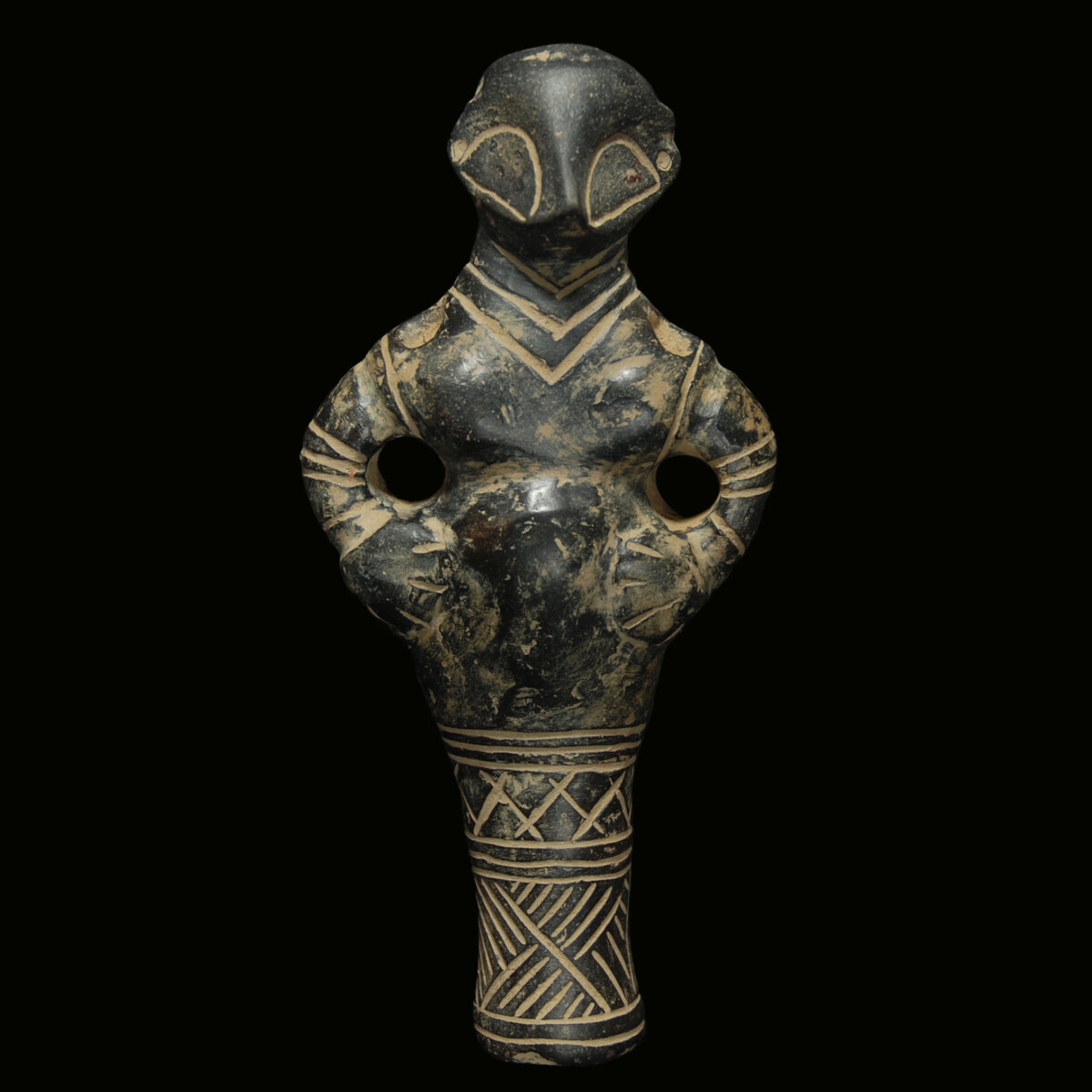
|
|
|
|
|
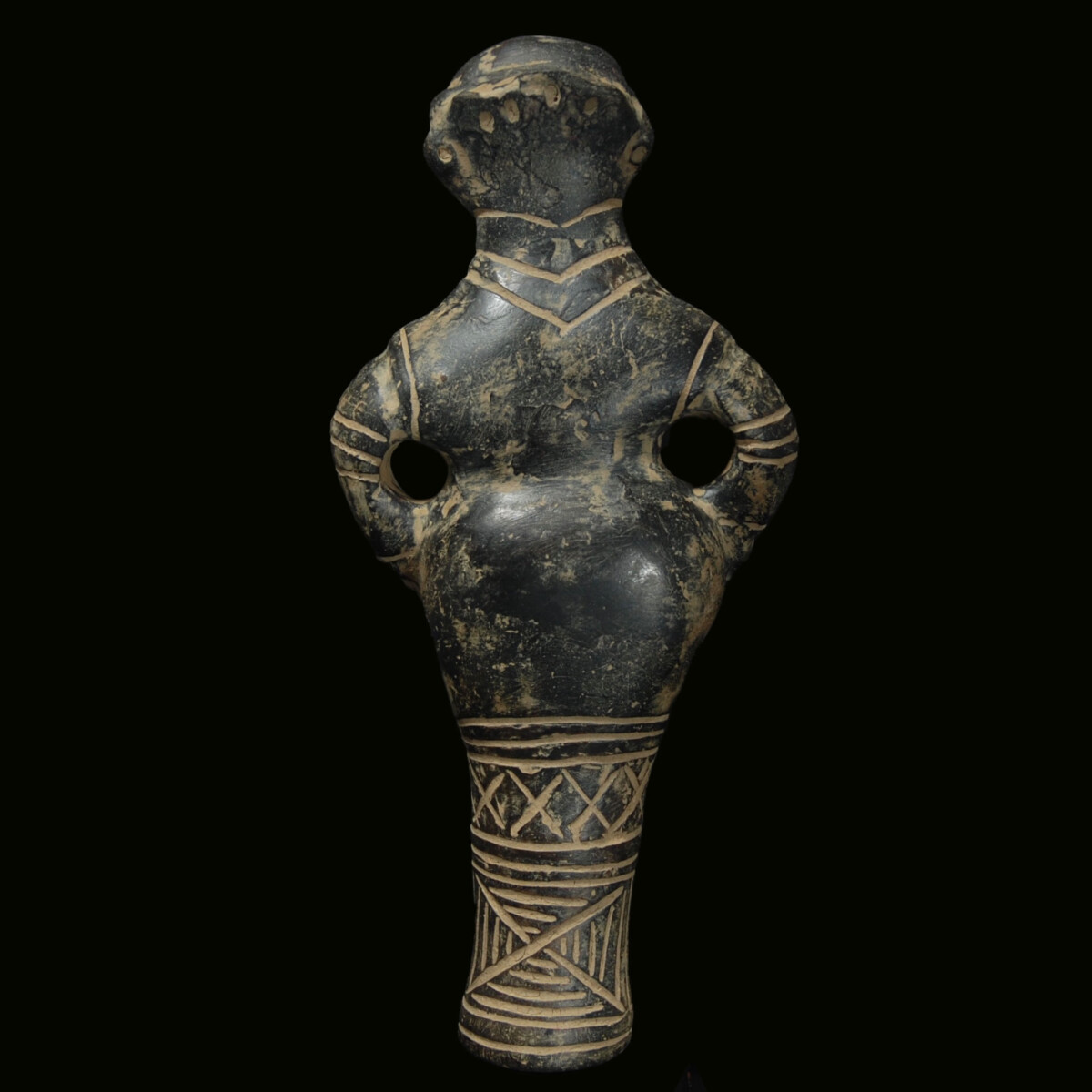
|
|
Southeastern Europe – 5500-4500 B.C.
|
Exceptionally large and well-preserved clay figure of the Vinča culture made of black-grey clay. The triangular head with large, semicircular engraved eyes. The pointy, long nose merges directly into the chin and creates the typically mask-like appearance on the face. On the round back of the head an inwardly curved headcover. The sideways protruding ears are pierced, on the neck a tripartite, V-shaped jewellery. The arms are sideways semi-circularly protruding and abundantly decorated with circles. The large hands rest on the round belly, the fingers are accentuated with incisions. Both shoulders are on top deeply pierced. The broad pelvis merges directly into the cylindrical abdomen, which is abundantly adorned with incised decoration. The legs are not accentuated, the foot ring is slightly inverted. Vinča figures such as the present one were used for ritual purposes. The position of the hands and the rounded belly of this very large statuette probably indicate a fertility cult. From the region of Supska-Stublina. With a TL test from the University of Vienna of summer 2023, confirming the age of the figure.
|
Provenance: From the well-known Vinča collection of Dusan Jovanovic (1956-2015), since 1970 in Austria. Accompanied by a thermoluminescence test confirming the age of the statuette.
Dimensions: 20.4 cm high
Price: 32 000 Euro
|
|
|
Südosteuropa – 5500-4500 v. Chr.
|
Außergewöhnlich große und gut erhaltene Tonfigur der Vinča-Kultur aus schwarzgrauem Ton. Der dreieckige Kopf mit halbrund eingravierten, großen Augen. Die spitze, lange Nase geht direkt in das Kinn über und gibt dem Gesicht sein typisch maskenhaftes Aussehen. Am runden Hinterkopf eine nach innen gewölbte Kopfbedeckung. Die seitlich abstehenden Ohren sind gelocht, um den Hals hängt ein dreigliedriger, V-förmiger Schmuck. Die Arme stehen seitlich halbrund ab und sind reich mit Ringen verziert. Die großen Hände liegen auf dem gewölbten Bauch auf, die Finger sind durch Ritzungen akzentuiert. Die Schultern sind oben auf beiden Seiten tief gelocht. Das breite Becken geht direkt in den zylindrischen Unterleib über, der reich mit Ritzdekor verziert ist. Die Beine sind nicht akzentuiert, die Standfläche ist leicht nach innen gewölbt. Vinča-Figuren wie diese wurden für kultische Zwecke eingesetzt. Handhaltung und Bauchrundung weisen bei dieser sehr großen Statuette wohl auf einen Fruchtbarkeitskult hin. Aus der Gegend von Supska-Stublina. Mit TL-Test der Universität Wien vom Sommer 2023, der das Alter der Figur bestätigt.
|
Provenienz: Aus der bekannten Vinča-Sammlung von Dusan Jovanovic (1956-2015), seit 1970 in Österreich. Mit Thermolumineszenz-Test, der das Alter der Statuette bestätigt.
Höhe: Höhe 20,4 cm
Preis: 32.000 Euro
|
|
|
|
Selected Artworks of the Month:
|
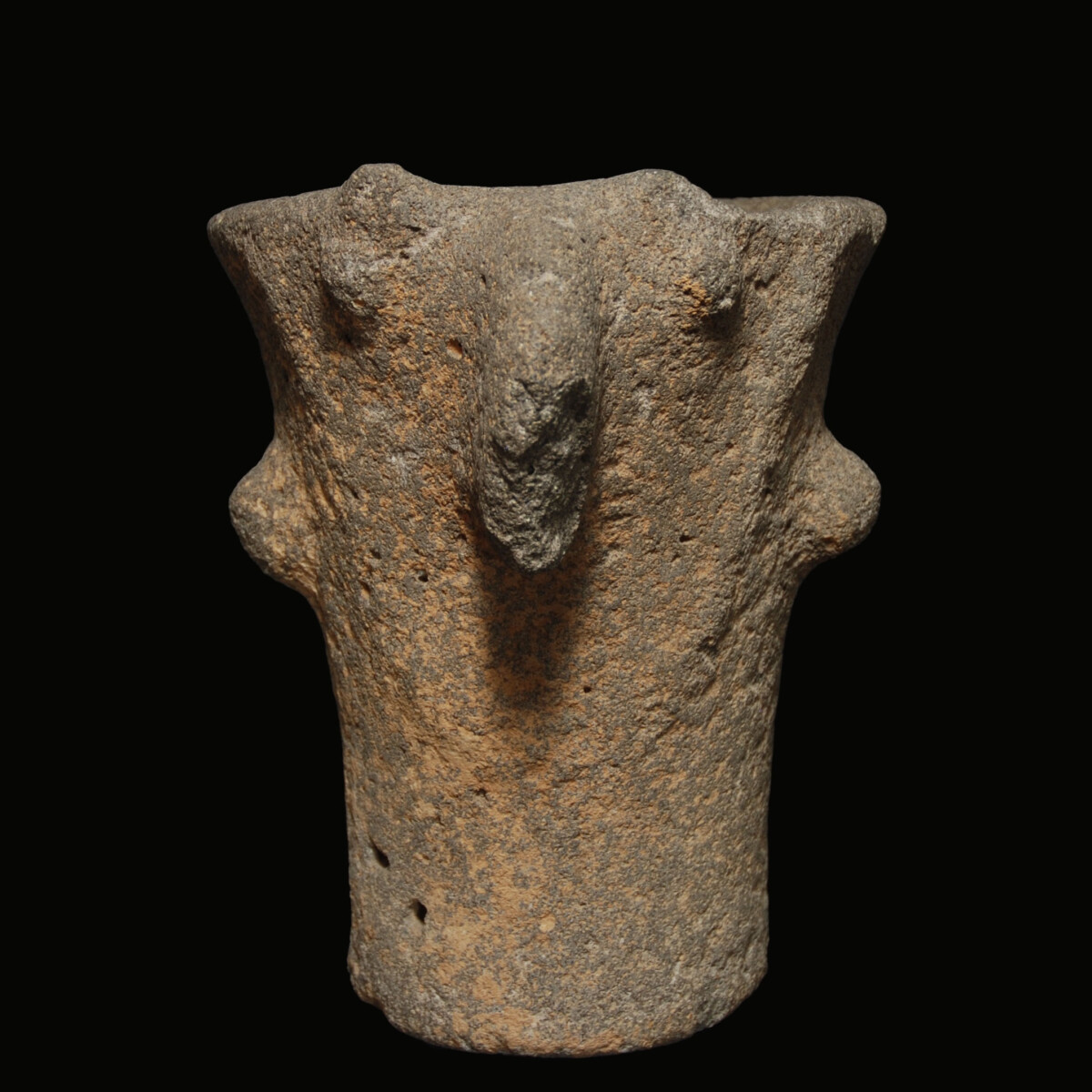
|
|
|
|
|
|
Levant/Golan Heights – 4th millennium B.C.
|
Columnar statue of local basalt from the Golan Heights, which served as a house deity and altar during the Chalcolithic period. The face of the deity with a large, far protruding nose, symbolizing the breath of life. On the sides bulging large eyes, which protrude over the rim. The face is framed by a slight rib, which is to be interpreted as a beard. Right and left thereof round protruding ears, which once served as handles of the heavy altar. The top has the form of a bowl, where the offerings are presented. This should appease the deity to protect the household and boost the fertility of livestock. These iconographically unique altars are only known from the Golan Heights in western Syria. See: Claire Epstein “The Chalcolithic Culture of the Golan”, in “The Biblical Archaeologist”, May 1977, p. 56-62. As well as: Ruth Amiran and Naomi Porat “The Basalt Vessels of the Chalcolithic Period and Early Bronze Age I”, Tel Aviv 1984. For a very similar example see Christie’s auction London on 5 July 2023, lot 65.
|
Provenance: Auctioned with Christie's New York on 18 December 1998, lot 254. Thence acquired by the Belgian collection M. Schoulmers. Until 2022 in a family estate. Last in the English art market.
Dimensions: 30.2 cm high
Price: 18 000 Euro
|
|
|
Levante/Golan Höhen – 4. Jahrtausend v. Chr.
|
Säulenförmige Statue aus lokalem Basalt von den Golan-Höhen, die in chalkolithischer Zeit als Hausgottheit und Altar diente. Das Gesicht der Gottheit mit großer, weit hervorragender Nase, die für den Lebensatem steht. Seitlich davon quellen die großen Augen hervor, die über den Rand hinausstehen. Das Gesicht wird von einer leichten Rippe eingerahmt, die als Bart zu deuten ist. Außerhalb davon stehen links und rechts runde Ohren ab, die einst als Henkel des schweren Altars dienten. Die Oberseite hat die Form einer Schale, in der Opfergaben dargebracht wurden. Damit sollte die Gottheit gnädig gestimmt werden, den Haushalt zu schützen und die Fruchtbarkeit der Nutztiere zu fördern. Diese ikonografisch einzigartigen Altäre sind bisher nur von den Golanhöhen im westlichen Syrien bekannt. Vergleiche dazu: Claire Epstein „The Chalcolithic Culture of the Golan”, in „The Biblical Archaeologist”, Mai 1977, S. 56-62. Sowie: Ruth Amiran und Naomi Porat “The Basalt Vessels of the Chalcolithic Period and Early Bronze Age I”, Tel Aviv 1984. Vergleiche ebenso Christie’s Auktion London vom 5. Juli 2023, Los 65.
|
Provenienz: Versteigert bei Christie’s New York am 18. Dezember 1998, Los 254. Dort erworben von der belgischen Sammlung M. Schoulmers. Bis 2022 in Familienbesitz. Zuletzt im englischen Kunsthandel.
Höhe: 30,2 cm
Preis: 18.000 Euro
|
|
|
|
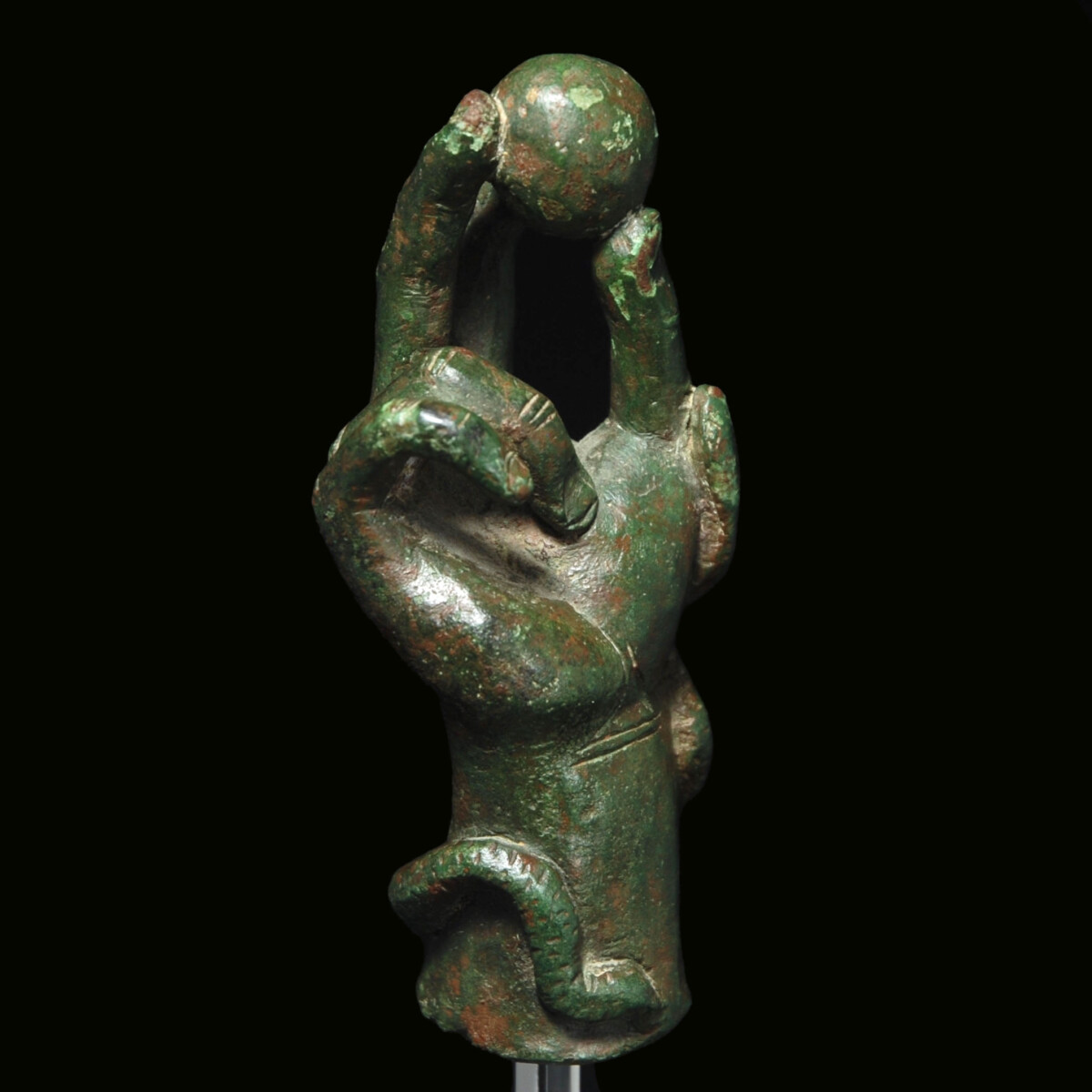
|
|
|
|
|
|
Roman Empire – 2nd-3rd century A.D.
|
Heavy bronze hand with a serpent and a ball, which was used in the Sabazios cult. The anatomically finely worked out hand with nails and limb folds has an opening in the lower arm, where it was affixed as a standard attachment on a wood staff and presented during processions. The serpent with a finely engraved skin winds around the wrist and rests its head on the thumb. It is closely associated with Sabazios, who is considered as the representative of the circle of nature, which every year blossoms and withered and re-blossoms. The serpent is the symbol for the constant renewal of life and nature. The finger position with the bent small- and ring finger, as well as the stretched out middle- and index finger, as well as thumb correspond to the “Benedictio Latina”, the blessing gesture, which is typical for Sabazios hands. Interesting is that the hand holds a ball, which are usually known for votive hands for Jupiter Dolichenus (see: Karin Guggisberg „Eine Votivhand für Jupiter Dolichenus aus Augst“, in: Jahresberichte aus Augst und Kaiseraugst, vol. 13, 1992, pages 121-128). It represents the globe, the cosmic omnipotence, which was associated with Sabazios. The Sabazios cult initially originates from Asia Minor and Thrace and spread through Roman legionnaires also in the western half of the empire. The cult rituals were orgiastic and exclusively took place at night, when also these Sabazios hands were used. See for the hand gesture and the symbols of the Sabazios hands: Susanne Berndt “The hand gesture and symbols of Sabazios”, in: “Opuscula Volume 11”, Stockholm 2018, p. 151-168. Mounted.
|
Provenance: Private collection Shlomo Moussaieff (1925-2015), Israel. Acquired between 1948 and 2000.
Dimensions: 12 cm high; 515 grams
Price: 6 000 Euro
|
|
|
Römisches Reich – 2.-3. Jahrhundert n. Chr.
|
Schwere Bronze-Hand mit Schlange und Kugel, die im Sabazios-Kult Verwendung fand. Die anatomisch fein modellierte Hand mit Fingernägeln und Gliederfalten hat am Unterarm eine Öffnung, wo sie als Standartenaufsatz auf einen Holzstab aufgesetzt und in Prozessionen vorgeführt wurde. Die Schlange mit fein gravierter Haut windet sich um das Handgelenk und legt den Kopf am Daumenansatz ab. Sie ist eng mit Sabazios verbunden, der als Repräsentant des Kreislaufs der Natur gesehen wurde, die jährlich erblüht und verwelkt und dann wieder erblüht. Die Schlange ist dabei das Sinnbild für die ständige Erneuerung des Lebens und der Natur. Die Fingerhaltung mit dem abgewinkelten kleinen Finger und Ringfinger sowie gestreckten Mittel- und Zeigefinger sowie Daumen entspricht der „Benedictio Latina“, dem Segensgestus, der typisch für Sabazios-Hände ist. Auffällig ist, dass die Hand eine Kugel hält, die man sonst von Votivhänden für Jupiter Dolichenus kennt (vergleiche dazu: Karin Guggisberg „Eine Votivhand für Jupiter Dolichenus aus Augst“, In: Jahresberichte aus Augst und Kaiseraugst, Band 13, 1992, Seite 121-128). Sie steht für den Globus, die kosmische Allmacht, mit der Sabazios in Verbindung gebracht wurde. Der Sabazios-Kult stammt ursprünglich aus Kleinasien und Thrakien und verbreitete sich über römische Legionäre auch in der westlichen Reichshälfte. Die Kulthandlungen waren orgiastisch und wurden ausschließlich in der Nacht abgehalten. Dabei fanden auch diese Sabazios-Hände Verwendung. Vergleiche zur Handhaltung und den Symbolen der Sabazios-Hände: Susanne Berndt „The hand gesture and symbols of Sabazios“, in: „Opuscula Volume 11“, Stockholm 2018, S. 151-168. Gesockelt.
|
Provenienz: Amerikanische Privatsammlung Arnold-Peter Weiss, Rhode Island, erworben bei Frank L. Kovacs Ancient Coins & Antiquities in San Mateo, Kalifornien, im Jahr 1999.
Höhe: 12 cm; Gewicht: 515 Gramm
Preis: 6.000 Euro
|
|
|
|
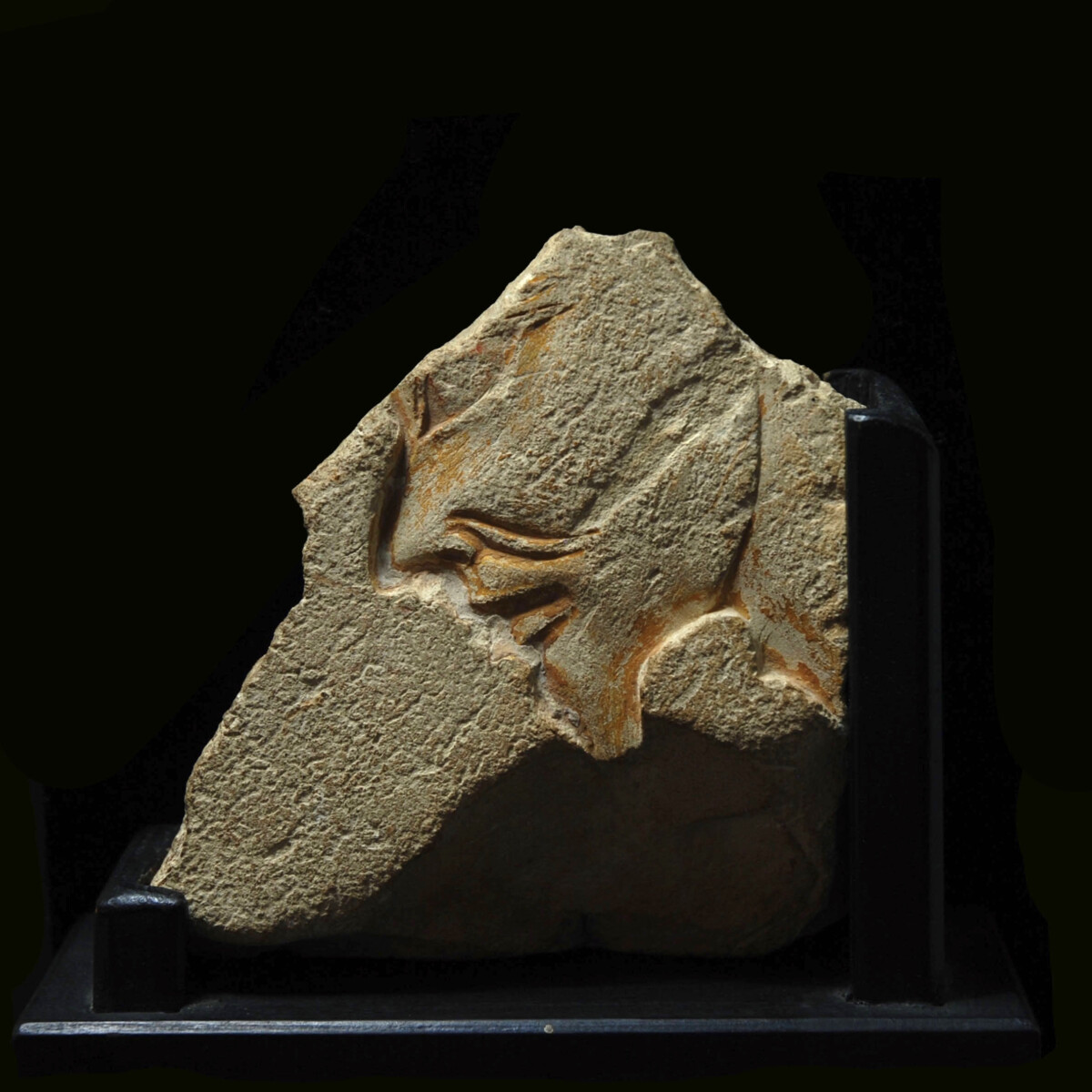
|
|
Egypt – 18th dynasty, Amarna period, 1351-1334 B.C.
|
Small, but high-quality limestone fragment depicting a bowed head of a captive Libyan. The features with almond-shaped eyes, typical for the Amarna style, the bulging lips and the slender face shape. The attribution to a captive Libyan is underlined by the goatee, as well as the deeply worked out, parallel and curved nasolabial folds. See for reference the sandstone relief of two captives in the Allard Pierson Museum in Amsterdam, Netherlands, with the inventory number APM 8753, and the limestone relief with a procession of foreigners in the Metropolitan Museum of Art with the Accession Number 1985.328.13, both also dating to the Amarna period. As for the depiction of a Libyan with a goatee see the glazed relief of a tile from the Ramesside period in the British Museum with the Registration Number 1871,0619.347. Mounted.
|
Provenance: US private collection Joseph Halle Schaffner (1897-1972). Thence in the collection Elmer "Pete" Schlesinger (1919-1982), Chicago. Thence in a family estate.
Dimensions: 10.5 cm x 10.2 cm
|
|
|
Ägypten – 18. Dynastie, Amarna-Periode, 1351-1334 v. Chr.
|
Kleines, aber hochwertig gearbeitetes Kalksteinfragment, das den gebeugten Kopf eines gefangenen Libyers zeigt. Die Gesichtszüge mit den für den Amarna-Stil typischen mandelförmigen Augen, den wulstigen Lippen und der schlanken Gesichtsform. Die Zuordnung an einen gefangenen Libyer wird durch den spitzen Kinnbart sowie die tief gearbeiteten, parallel und geschwungen verlaufenden Nasolabialfalten deutlich. Vergleiche dazu das Sandsteinrelief mit zwei Gefangenen im Allard Pierson Museum in Amsterdam mit der Inventarnummer APM 8753 und das Kalksteinrelief mit einer Prozession von Ausländern im Metropolitan Museum of Art mit der Accession Number 1985.328.13, die beide ebenfalls in die Amarna-Periode datieren. Sowie zur Darstellung eines Libyers mit Spitzbart das glasierte Relief auf einer Fliese aus ramessidischer Zeit im British Museum mit der Registration Number 1871,0619.347. Gesockelt.
|
Provenienz: Amerikanische Privatsammlung Joseph Halle Schaffner (1897-1972). Danach in der Sammlung Elmer „Pete“ Schlesinger (1919-1982), Chicago. Seitdem in Familienbesitz.
Dimensionen: 10,5 cm x 10,2 cm
Preis: 6.800 Euro
|
|
|
|
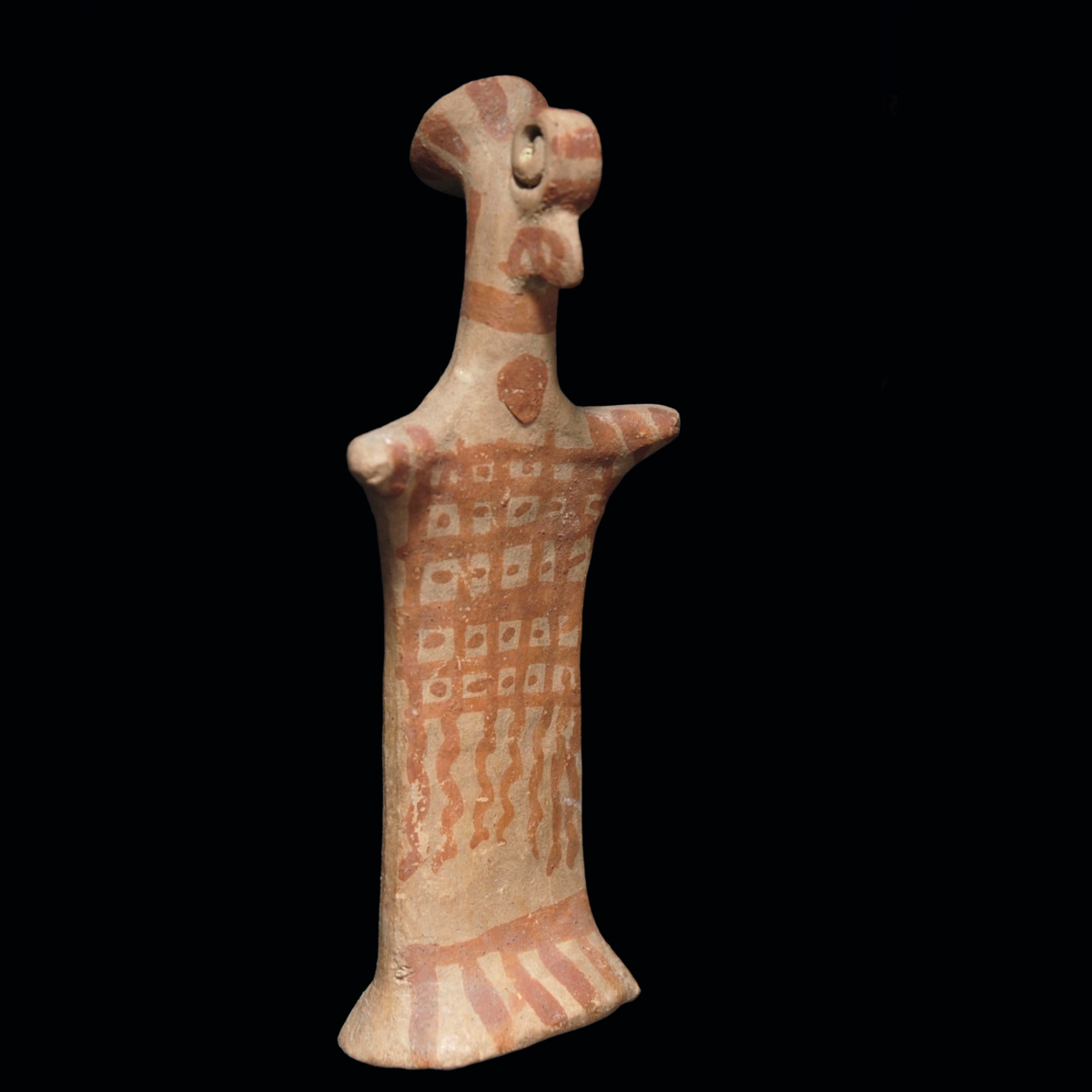
|
|
|
|
|
|
|
|
Greece/Boeotia – mid 6th century B.C.
|
Plank idol with a flat body formed by hand, merging at the bottom to an oval foot ring and on top to a cylindrical neck. The bird-like face with a beak-shaped nose and red painted eyes. The figure wears a cupped polos at the back of the head identifying her as a goddess. On the forehead a large, inwardly rolled volute, suggesting a quiff. The short arms are protruding on the sides, slightly bent forward and tapering. The necklace and the dress, abundantly decorated with geometric forms, is painted in red. At the back wavy hair strands cascade to the nape. Idols such as the present one probably represent goddesses (Demeter or Hera). Due to their headdress they are also called Papades.
|
Provenance: German private collection J. Gutbrod (died 2017), acquired in the 1960s to 1990s in the German art market. Thence by descent to Micaela Gutbrod, Munich, Germany.
Dimensions: 13.6 cm high
|
|
|
Griechenland/Böotien – Mitte 6. Jahrhundert v. Chr.
|
Handgeformtes Brettidol mit flachem Körper, der nach unten zu einem ovalen Standring ausschwingt und nach oben in einen zylindrischen Hals übergeht. Das vogelähnliche Gesicht mit schnabelförmiger Nase und in roter Farbe aufgemalten Augen. Die Figur trägt einen schalenförmigen Polos am Hinterkopf, der sie als Göttin ausweist. Auf der Stirn hat sie eine große, nach innen gerollte Volute, die wohl als Haartolle zu deuten ist. Die kurzen Arme sind seitlich weggestreckt, leicht nach vorne gebogen und spitz auslaufend. Der Halsschmuck und das reich in geometrischen Formen dekorierte Kleid sind in Rot aufgemalt. Auf der Rückseite fallen der Göttin lange, gewellte Haarsträhnen in den Nacken. Idole wie dieses stellen vermutlich Göttinnen (Demeter oder Hera) dar. Sie werden aufgrund des Kopfschmucks auch als Papades bezeichnet.
|
Provenienz: Deutsche Privatsammlung J. Gutbrod (verstorben 2017), erworben in den 1960er bis 1990er Jahren am deutschen Kunstmarkt. Danach durch Erbe an Micaela Gutbrod, München.
Höhe: 13,6 cm
Preis: 2.800 Euro
|
|
|
|

|
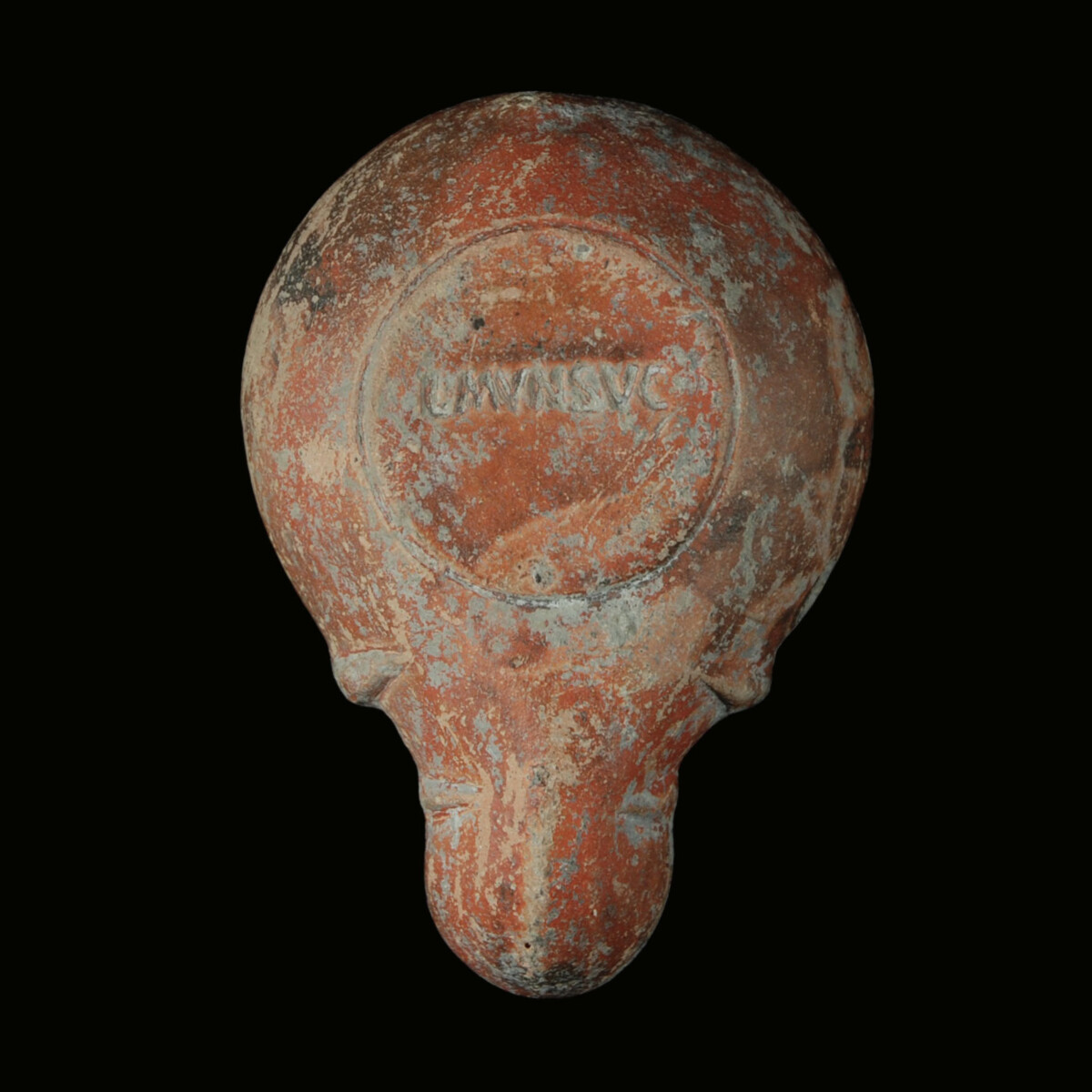
|
|
Roman Empire – 1st century A.D.
|
Signed oil lamp of brown clay without handle of the Loeschcke IV type. The high quality relief on the mirror depicts a dwarf couple making love on pillows in the form of an overlarge phallus. She has her arms stretched out, sits on him and looks around. The male dwarf with a large head and thick curls leans with the right elbow on the kline and stretches the left one upwards. Below the scene is the round pouring hole. The depiction is framed by a flute, followed by the semicircularly sloping shoulder. The round snout with a large nozzle is separated from the mirror by two volutes, which merge into buttons. The lamp stands on a ring foot stamped with the manufacturer's mark “LMVNSVC”. See for the type the oil lamp in Vindonissa Museum in Brugg/Aargau, Switzerland with the inventory number 41.276, 3431 and 3432, published in: “Sexual art on Roman lamps: analysis of provincial data” in: Journal of Roman Archaeology 36 (2023), p. 23-49.
|
Provenance: From the estate of the French archaeologist Suzanne Gozlan (1921-2022), professor at the l’Ecole Normale d’Instituteurs de Chartres and lecturer at the Parisian Sorbonne.
Dimensions: 9.6 cm long
Price: 2 400 Euro
|
|
|
Römisches Reich – 1. Jahrhundert n. Chr.
|
Signierte Öllampe ohne Griff aus braunem Ton des Typs Loeschke IV. Das hohe und sehr plastische Relief am Spiegel zeigt ein Zwergenpaar beim Liebesspiel auf Pölstern, die die Form eines übergroßen Phallus haben. Sie, die Arme nach vorne gestreckt, sitzt dabei auf ihm und blickt sich um. Der männliche Zwerg mit großem Kopf und dicken Locken stützt sich mit dem rechten Ellenbogen auf der Kline auf und streckt die linke nach oben. Unter der Szene das runde Einfüllloch. Die Darstellung wird von einer Rille gerahmt, die daran anschließende Schulter halbrund abfallend. Die runde Schnauze mit großem Brennloch wird durch zwei Voluten, die in Knöpfen auslaufen vom Spiegel getrennt. Die Lampe steht auf einer Standfläche, in die die Herstellermarke „LMVNSVC“ gestempelt wurde. Vergleiche zum Typus die Öllampen im Vindonissa Museum in Brugg/Aargau in der Schweiz mit den Inventarnummern 41.276, 3431 und 3432, publiziert in: Sanja Vucetic „Sexual art on Roman lamps: analysis of provincial data“ in: Journal of Roman Archaeology 36 (2023), S. 23-49.
|
Provenienz: Aus dem Nachlass der französischen Archäologin Suzanne Gozlan (1921-2022), Professorin an der l’Ecole Normale d’Instituteurs de Chartres und Dozentin an der Pariser Sorbonne.
Länge: 9,6 cm
Preis: 2.400 Euro
|
|
|
|

|
|
Phoenicia – 5th-4th century B.C.
|
Finely worked out glass head of a bearded man. The face of opaque yellow glass, the eyes applied with white and blue glass paste. On the forehead a small, white glass bead. The beard is blue and red and finely ribbed. On the sides the ears with white earrings. The hair applied with diagonally blue-white glass threads. Through the profiled blue suspension on the head the amulet was worn around the neck, possibly with apotropaic function. See for the typus the glass head in the Corning Museum of Glass with the Accession Number 68.1.15.
|
Provenance: American private collection, acquired from Herakles Numismatics on December 4, 1995. With a copy of the invoice.
Dimensions: 2.4 cm high
Price: 2 400 Euro
|
|
|
Phönizien – 5.-4. Jahrhundert v. Chr.
|
Fein gearbeiteter Glaskopf eines bärtigen Mannes. Das Gesicht aus opakem gelbem Glas, die Augen in weißer und blauer Glaspaste aufgelegt. Auf der Stirn ein kleines, weißes Kügelchen. Der Bart ist blau und rot und fein gerippt. Seitlich Ohren mit weißen Ohrringen. Das Haar ist aus diagonalen blau-weißen Glasfäden aufgelegt. Über die profilierte blaue Aufhängung am Kopf wurde das Amulett um den Hals getragen, wohl mit apotropäischer Funktion. Vergleiche zum Typus den Glaskopf im Corning Museum of Glass mit der Accession Number 68.1.15.
|
Provenienz: Amerikanische Privatsammlung, erworben bei Herakles Numismatik am 4. Dezember 1995. Mit Kopie der Rechnung.
Höhe: 2,4 cm
Preis: 2.400 Euro
|
|
|
|

|
|
|
|
|
|
Etruria – 6th century B.C.
|
Beautiful fragment of an Etruscan terracotta brick protome (antefix) in form of an archaic head of a woman. The face with fine, slender features with the typical large, almond-shaped eyes. The mouth is small, the chin is prominent. The wavy hair is parted in the middle and frames the forehead. On the left side the ear with a large, round earring is preserved. Possibly from Cerveteri. With an old collection number on the inside. Mounted.
|
Provenance: Private collection Michael Ratzenböck, Upper Austria. For at least 30 years in a family estate.
Dimensions: 16.8 cm high
Price: 1 800 Euro
|
|
|
Etrurien – 6. Jahrhundert v. Chr.
|
Schönes Fragment eines etruskischen Terrakotta-Stirnziegels (Antefix) in Form eines archaischen Frauenkopfes. Das Gesicht mit feinen, schlanken Zügen mit den typischen großen, mandelförmigen Augen. Der Mund ist klein, das Kinn ist ausgeprägt. Das wellige Haar ist in der Mitte gescheitelt und rahmt die Stirn ein. An der linken Seite ist noch das Ohr mit einem großen, runden Ohrring erhalten. Wohl aus Cerveteri. Mit alter Sammlungsnummer auf der Innenseite. Gesockelt.
|
Provenienz: Privatsammlung Michael Ratzenböck, Oberösterreich. Seit zumindest 30 Jahren in Familienbesitz.
Höhe: 16,8 cm
Preis: 1.800 Euro
|
|
|
|
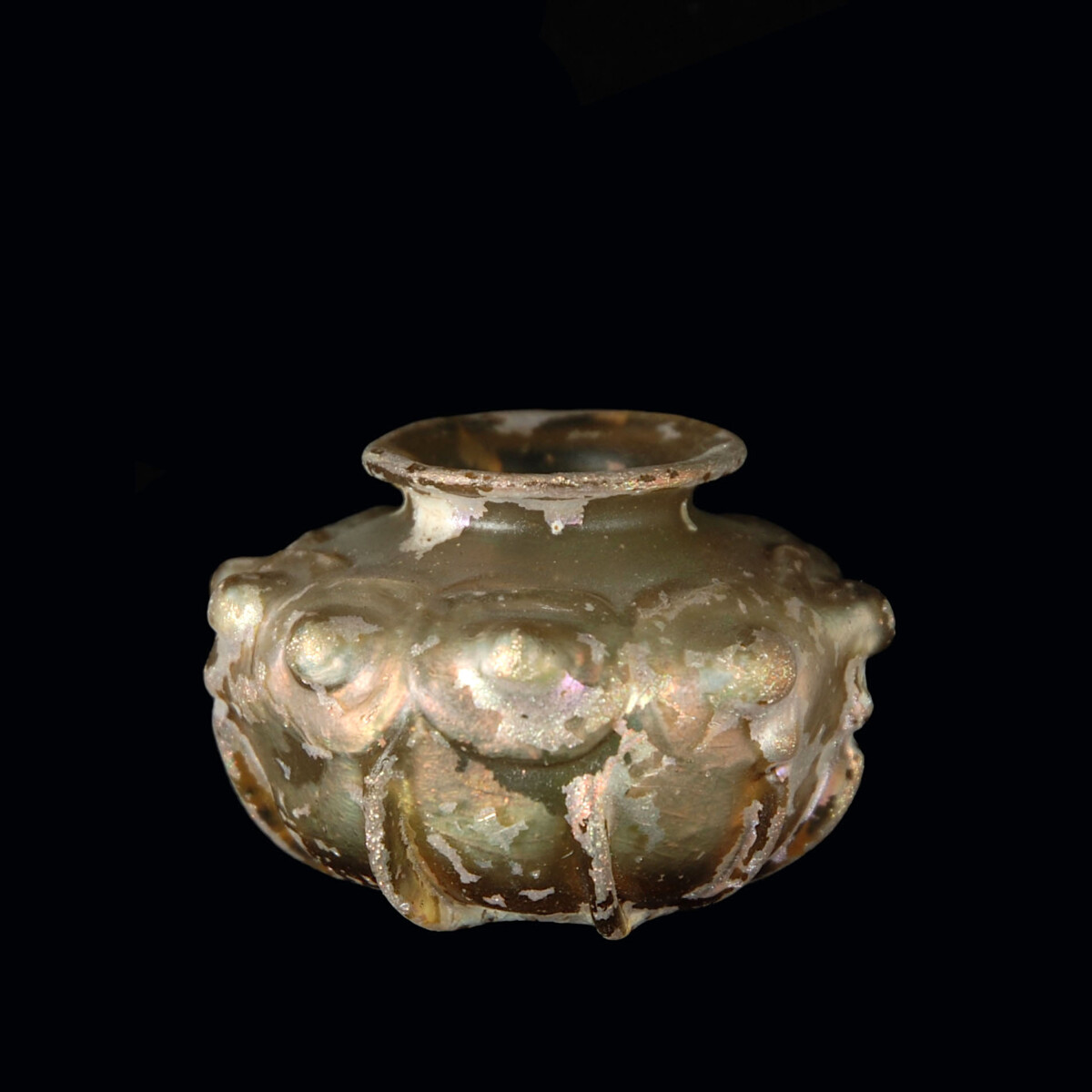
|
|
|
|
|
|
Roman Empire – 2nd half of 1st century A.D.
|
Very appealing flask of yellowish clear glass, blown into form, which probably once served as an ink bottle. The flask stands on an inwardly curved base, from which eight sculptural ribs reach the centre of the body. Ten round bosses protrude from the shoulder in a star shape. Each boss is framed by a three dimensional circle. The neck is short, the rim far protruding. The flask radiates with wonderfully silver shimmering iridescence. A very rare form.
|
Provenance: French private collection Michel Peytel (1919-1973), who kept his collection in his city palais ("Hôtel particulier") at Place Vendôme in Paris.
Dimensions: 6.3 cm in diameter; 4.3 cm high
Price: 4 800 Euro
|
|
|
Römisches Reich – 2. Hälfte 1. Jahrhundert n. Chr.
|
Überaus reizvolle, in die Form geblasene Schale aus gelblichem Klarglas, die wohl einst als Tintenfläschchen diente. Die Schale steht auf einer nach innen gewölbten Basis, von der acht plastische Rippen ausgehen, die bis zur Mitte des Korpus ragen. Darüber ragen zehn runde Buckel sternförmig aus der Schulter. Die Buckel jeweils von einem plastischen Kreis umrahmt. Der Hals ist kurz, der Rand weit nach außen gebogen. Das Fläschchen mit wunderbarer silber schimmernder Irisierung. Eine ausgesprochen seltene Form.
|
Provenienz: Französische Privatsammlung Michel Peytel (1919-1973), der seine Sammlung in seinem Stadtpalais („Hôtel particulier“) am Pariser Place Vendôme aufbewahrte.
Dimensionen: Durchmesser 6,3 cm; Höhe 4,3 cm
Preis: 4.800 Euro
|
|
|
|
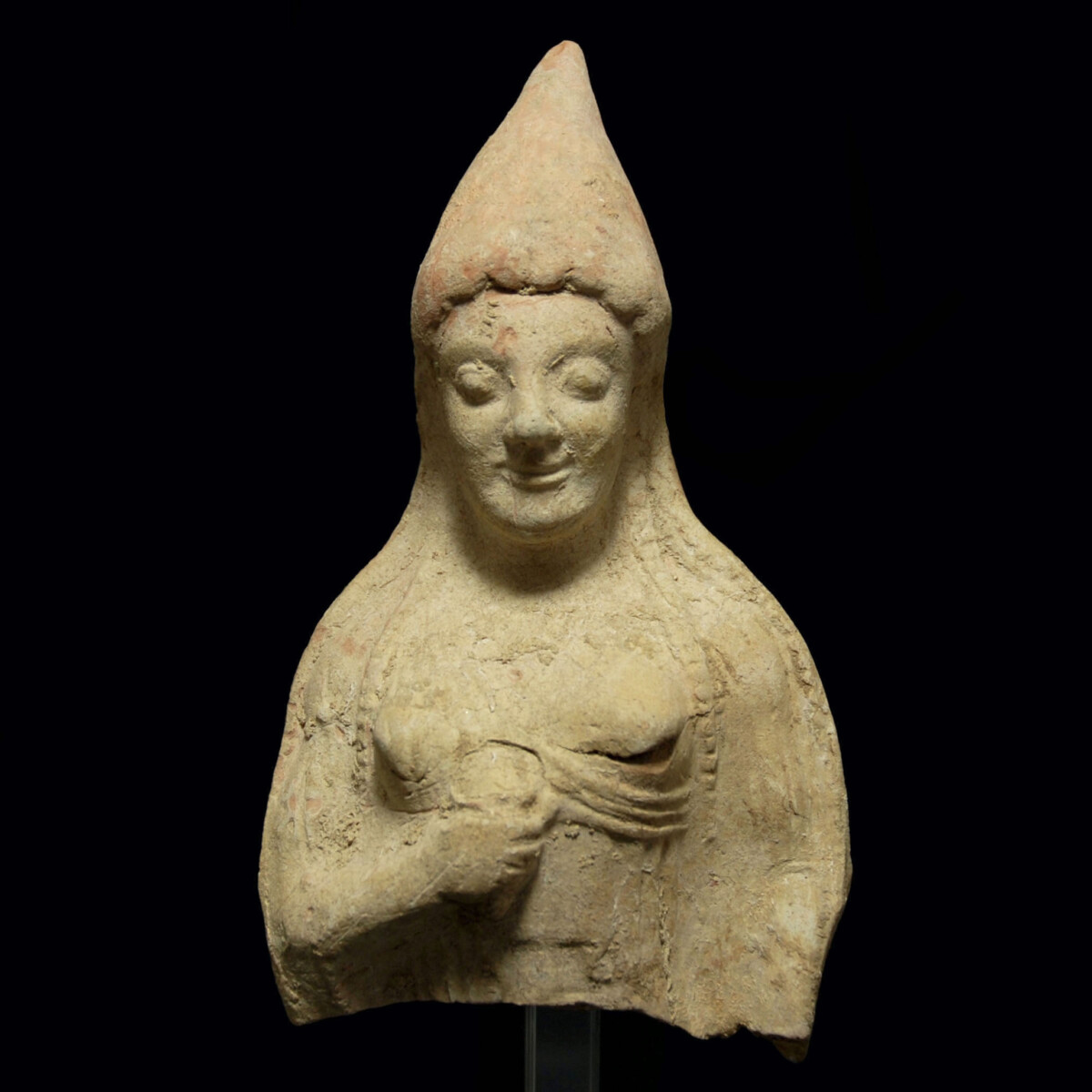
|
|
|
|
|
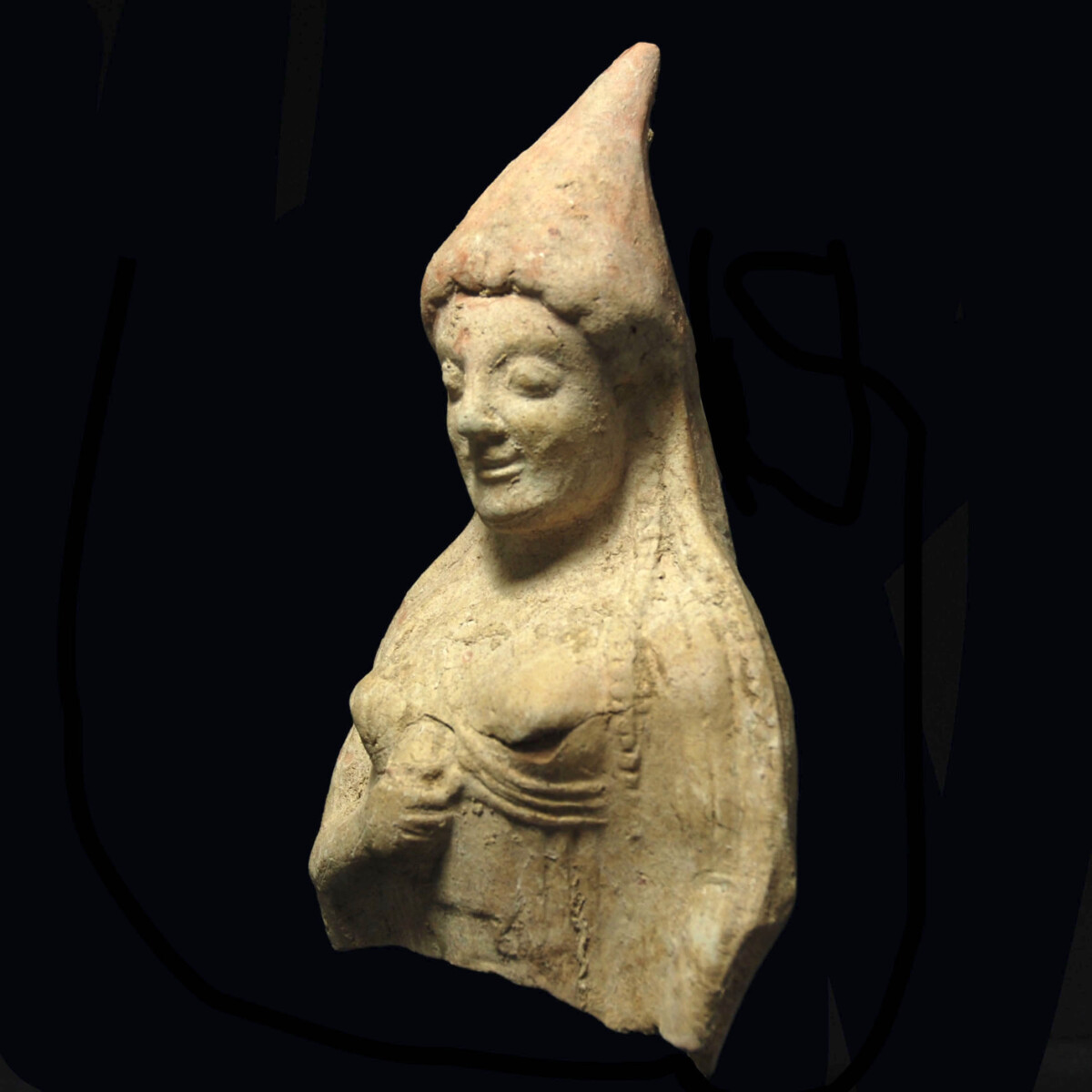
|
|
Cyprus – 6th century B.C.
|
Large archaic terracotta bust of a female goddess, possibly Persephone. The face with archaic features, the typical smile and almond-shaped eyes. The goddess wears a high tapering cap, underneath the wavy hair frames the forehead. Long braided strands cascade on the sides over the shoulder and next to the breasts. At the back her hair cascade in thick waves far down. Persephone holds in the right hand an attribute in front of her chest, possibly the pomegranate. After eating four seeds of a pomegranate in the Hades, she was forced to spend one month for each seed in the underworld, before she was allowed to return to the surface, and everything started to blossom. During the four months, which she spent in the Hades, the plants withered on the surface, and winter started. Persephone wears an elegant gown, which cover in arranged pleats chest, belly and arms. The bust was part of a large statue. It originates from the eastern part of the Mediterranean region, the head cover and the light clay refer to Cyprus. See for the cap of the statue the example in the Metropolitan Museum of Art with the Accession Number 74.51.2599. Mounted.
|
Provenance: Private collection George R. Francoeur (1934-2019), Michigan, acquired 1986 in Chicago. Thence in the US art market.
Dimensions: 21.4 cm high
Price: 2 600 Euro
|
|
|
Zypern – 6. Jahrhundert v. Chr.
|
Große archaische Terrakotta-Büste einer weiblichen Göttin, wohl Persephone. Das Gesicht mit archaischen Zügen, dem typischen Lächeln und mandelförmigen Augen. Die Göttin trägt eine hohe, spitz zulaufende Kappe, unter der das wellige Haar die Stirn einkreist. Lange geflochtene Strähnen fallen seitlich über die Schulter und neben die Brüste. Hinten fällt das Haar in dichten Wellen weit in den Rücken. Persephone hält mit der rechten Hand ein Attribut vor die Brust, wahrscheinlich den Granatapfel. Als sie im Hades vier Kerne eines Granatapfels aß, wurde sie gezwungen für jeden Kern einen Monat in der Unterwelt zu verbringen, ehe sie wieder auf die Erde durfte und diese erblühte. In den vier Monaten jedoch, die sie im Hades verweilen musste, verblühten auf der Erde die Pflanzen, der Winter kehrte ein. Persephone trägt feine Gewänder, die in geordneten Falten Brust, Bauch und Arme bedecken. Die Büste war Teil einer großen Statue. Sie stammt aus dem östlichen Mittelmeerrraum, Kopfbedeckung und der helle Ton verweisen auf Zypern. Vergleiche zur Kopfbedeckung die Statue im Metropolitan Museum of Art mit der Accession Number 74.51.2599. Gesockelt.
|
Provenienz: Privatsammlung George R. Francoeur (1934-2019), Michigan, erworben 1986 in Chicago. Danach im amerikanischen Kunsthandel.
Höhe: 21,4 cm
Preis: 2.600 Euro
|
|
|
|
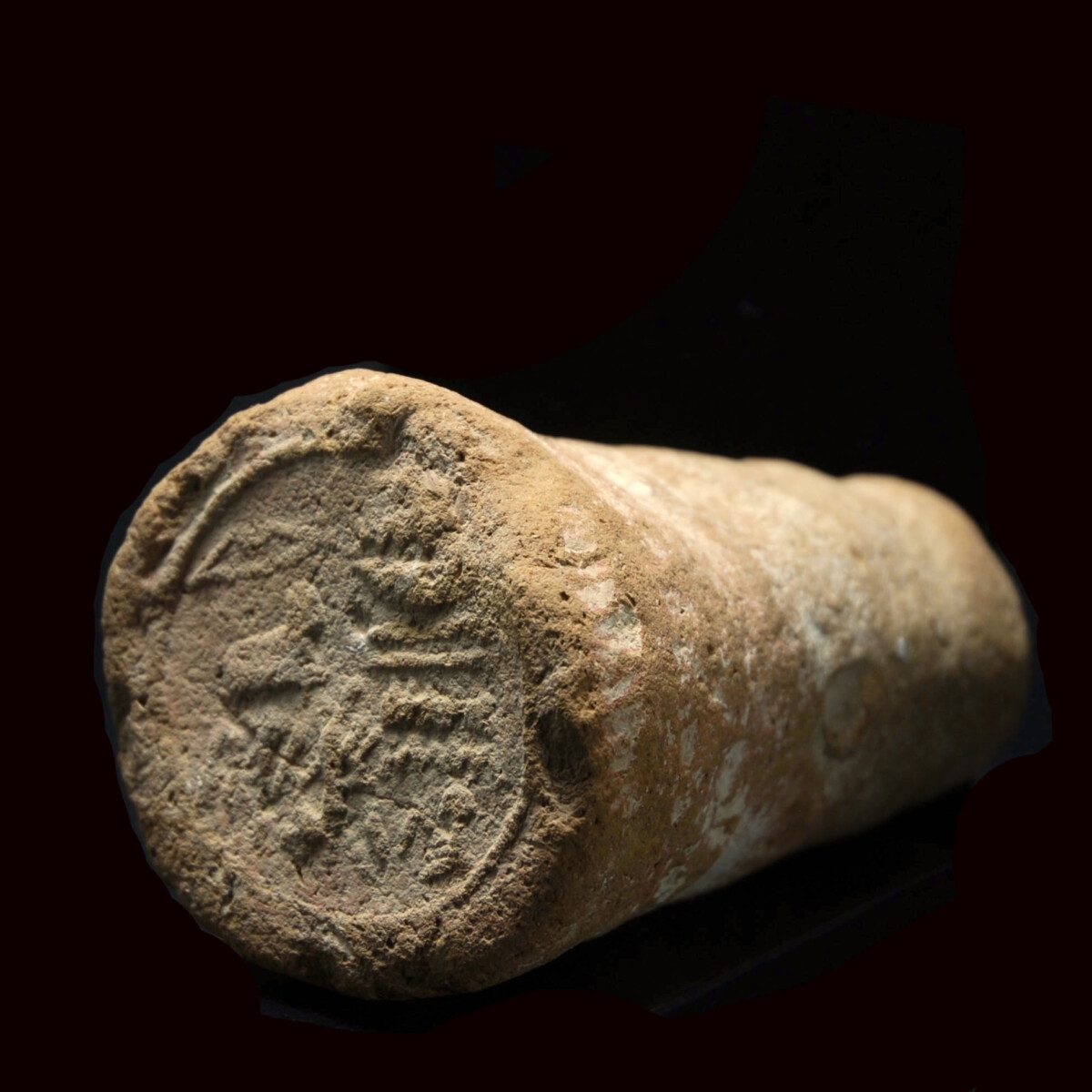
|
|
|
|
Egypt – New Kingdom, 18th dynasty, ca. 1400 B.C.
|
Beautifully preserved, inscribed funerary cone dating to the 18th dynasty. The stamp area depicts hieroglyphs in two registers mentioning “Meni, the military scribe of the ruler of the Two Lands”. This funerary cone belongs to the tomb TT 230 in Thebes. With a publication of the inscription and a publication of the attribution to tomb TT 230. Funerary cones of Meni are published in the standard work “A Corpus of Inscribed Egyptian Funerary Cones” by Norman de Garis Davies and Miles Frederick Laming Macadam, Oxford 1957 as number 292. Clay cones such as the present one were affixed at the tomb entrances, possibly pushed through the wet plaster of the lintel.
|
Provenance: From the estate of the Egyptologist A. B. (1941-2016). Acquired by him prior to 1983 in Great Britain.
Dimensions: 12.4 cm long
Price: 1 600 Euro
|
|
|
Ägypten – Neues Reich, 18. Dynastie, ca. 1400 v. Chr.
|
Schön erhaltener, beschrifteter Grabkegel aus der 18. Dynastie. Die Stempelfläche zeigt Hieroglyphen in zwei Registern, die über „Meni“ berichten, „den Armeeschreiber des Herrn über die zwei Länder“. Dieser Grabkegel gehörte zu Grab TT 230 in Theben. Mit einer Publikation der Inschrift und Publikation der Zuweisung zu Grab 230. Grabkegel des Meni sind im Standardwerk „A Corpus of Inscribed Egyptian Funerary Cones“ von Norman de Garis Davies und Miles Frederick Laming Macadam, Oxford 1957 als Nummer 292 publiziert. Tönerne Kegel wie dieser wurden an Grabeingängen angebracht, wahrscheinlich wurden sie in den feuchten Putz des Türsturzes geschoben.
|
Provenienz: Aus dem Nachlass des Ägyptologen A. B. (1941-2016). Von ihm erworben vor 1983 in Großbritannien.
Länge: 12,4 cm
Preis: 1.600 Euro
|
|
|
|
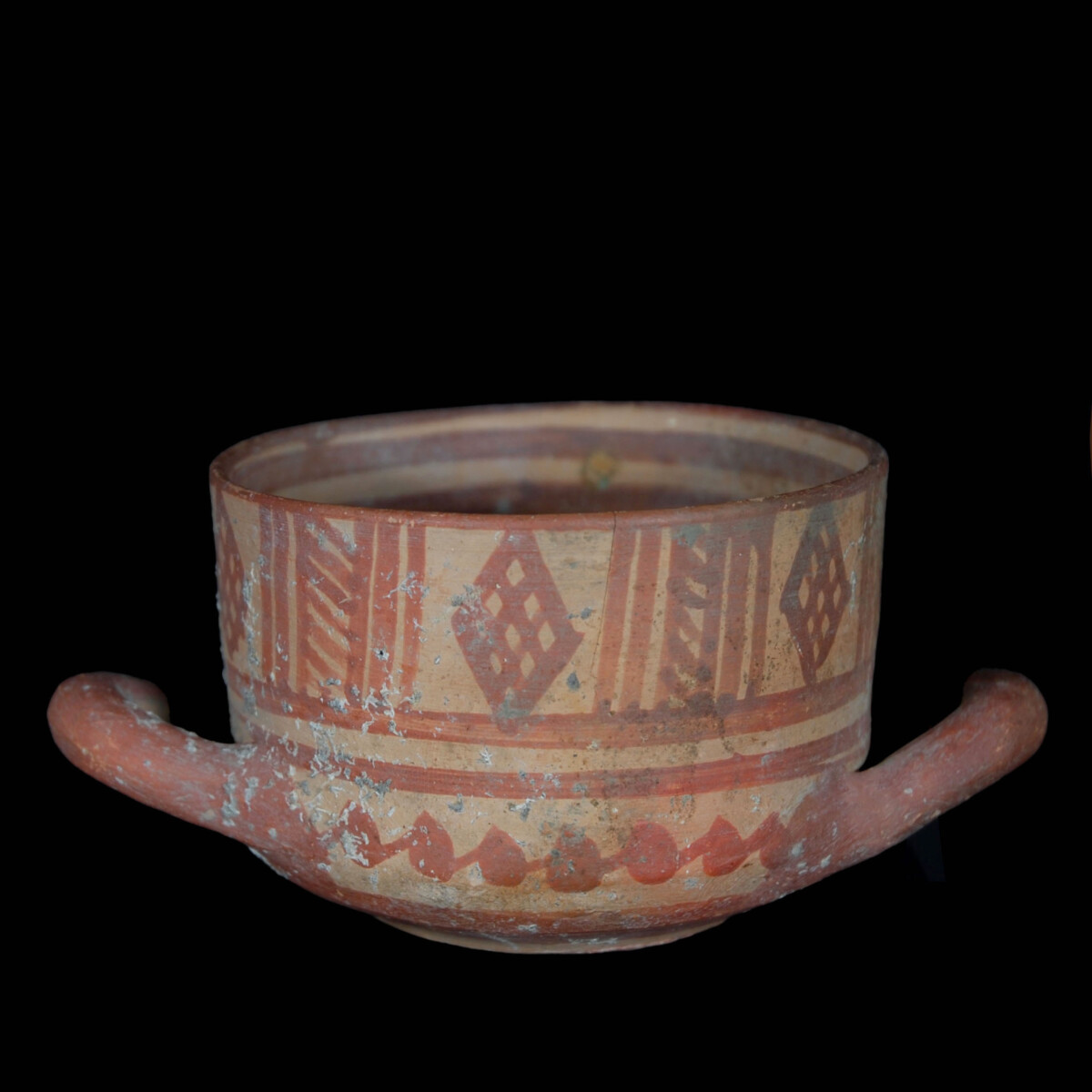
|
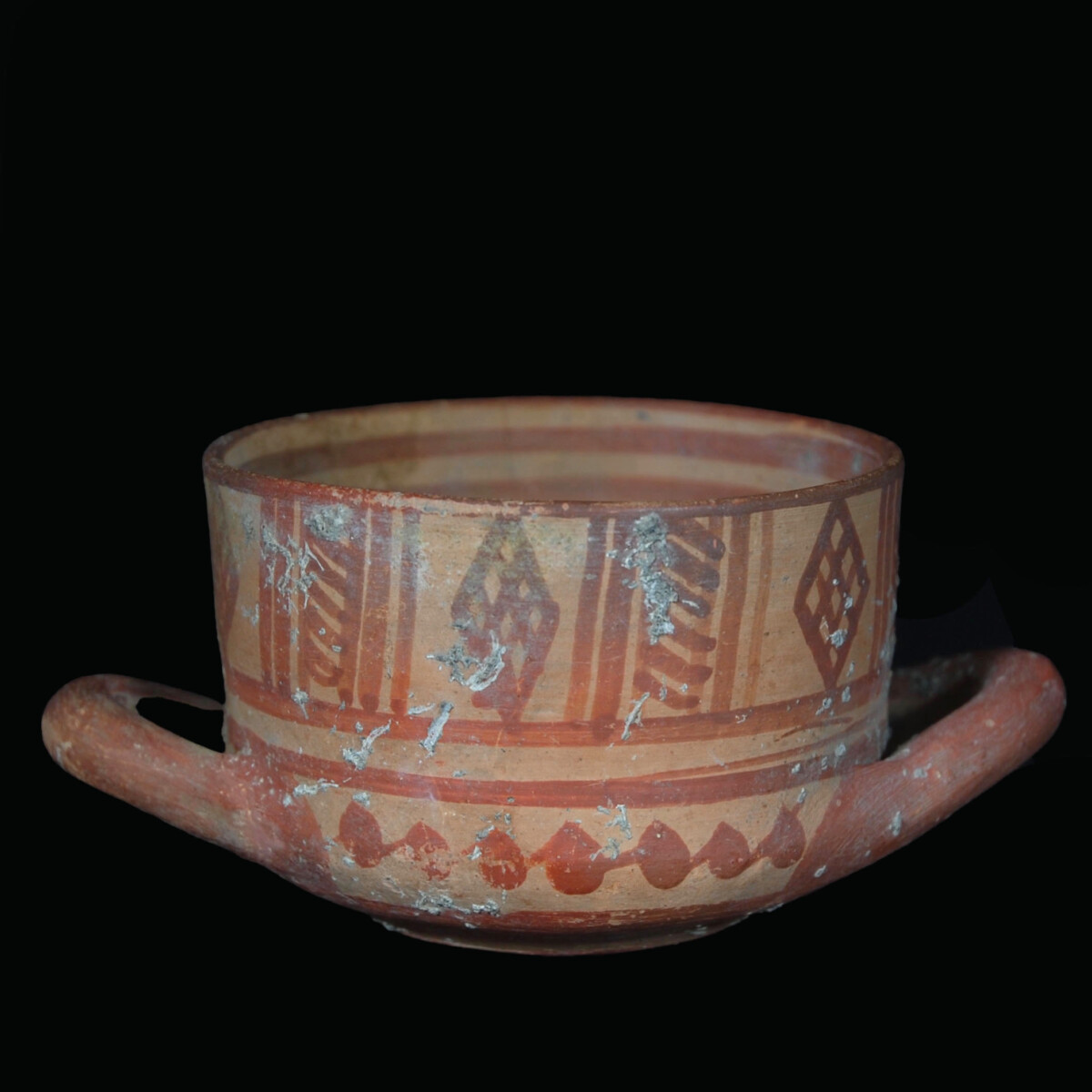
|
|
Greece – Late 8th century B.C.
|
An early form of a skyphos as a high-walled drinking cup with red geometric decoration on a white background. The vessel stands on a flat foot rim, where just above the slightly upwards pointing handles start. The cylindrical corpus is decorated with wavy bands, lines and lozenges. On the inside also encircling band decoration. The skyphos is similar in shape and painting to the vessels found in the first half of the 20th century on the Attic mountain ridge Hymettos. The majority can be found in numerous museums and private collections. See for example the collection of Hymettus ceramic in the Metropolitan Museum of Art, which was gifted by the Greek government.
|
Provenance: Private collection Michael Ratzenböck, Upper Austria. For at least 30 years in a family estate.
Dimensions: 6.4 cm high; 9,5 cm in diameter
Price: 800 Euro
|
|
|
Griechenland – Ende 8. Jahrhundert v. Chr.
|
Frühform des Skyphos als hochwandiges Trinkgefäß mit geometrischer Dekoration in roter Farbe auf weißem Grund. Das Gefäß steht auf einem flachen Standring, direkt darüber setzen die leicht nach oben gewandten Henkel an. Der zylindrische Korpus ist mit Wellenbändern, Linien und Rauten verziert. Auf der Innenseite ebenfalls umlaufende Banddekoration. Der Skyphos ähnelt in Form und Bemalung den Gefäßen, die in der ersten Hälfte des 20. Jahrhunderts am attischen Bergrücken Hymettos gefunden wurden und von denen sich heute ein Großteil in zahlreichen Museen und Privatsammlungen befindet. Vergleiche etwa die Sammlung von Hymettos Keramik im Metropolitan Museum of Art, die 1930 von der griechischen Regierung als Geschenk übergeben wurde.
|
Provenienz: Privatsammlung Michael Ratzenböck, Oberösterreich. Seit zumindest 30 Jahren in Familienbesitz.
Dimensionen: Höhe 6,4 cm; Durchmesser 9,5 cm
Preis: 800 Euro
|
|
|
|
|
|
|
|
|
CHRISTOPH BACHER ARCHÄOLOGIE ANCIENT ART GmbH
|
Galerie: Stubenring 20, A-1010 Wien
Showroom: Untere Viaduktgasse 55, A-1030 Wien
|
|
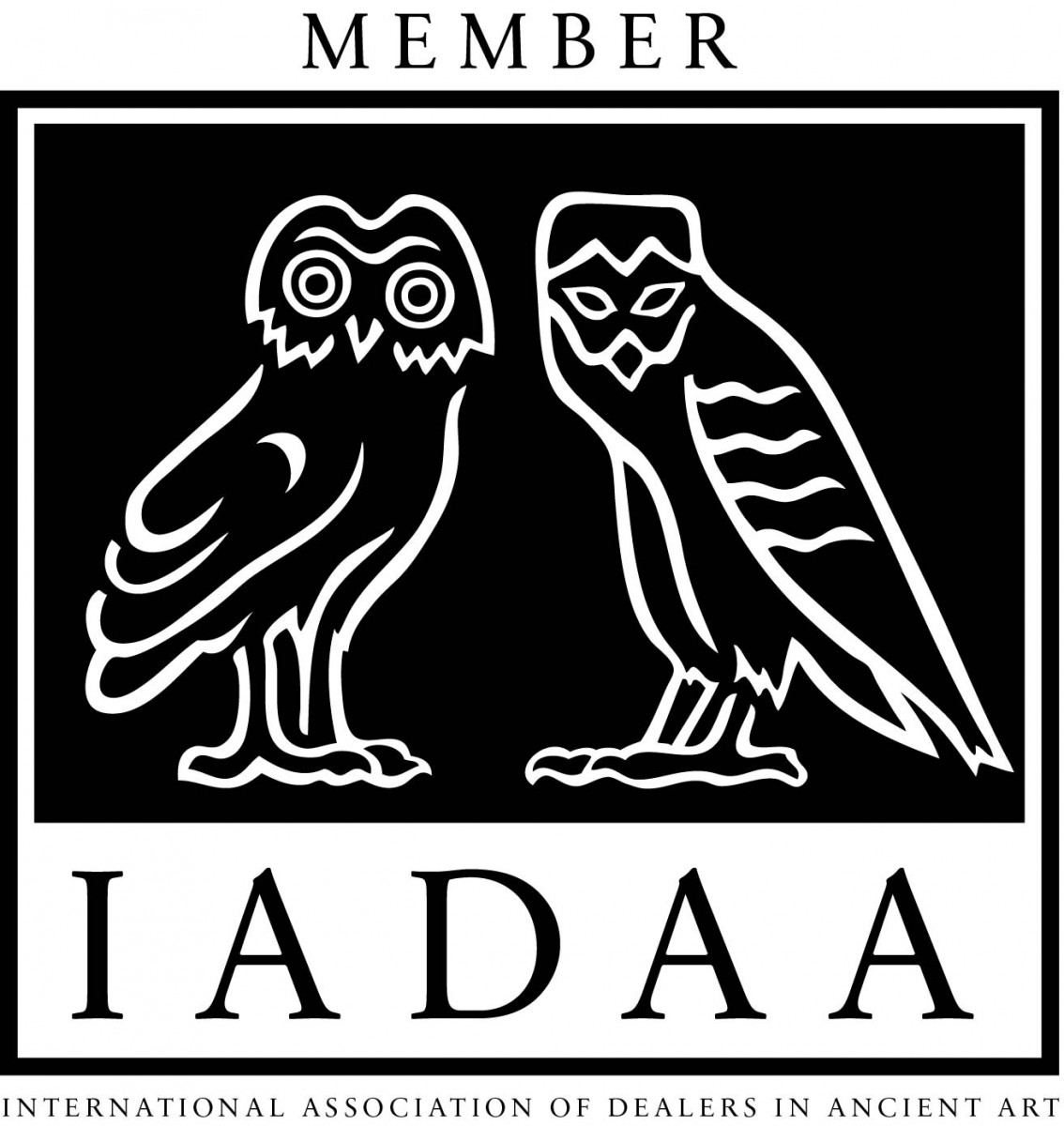
|
|
|
|